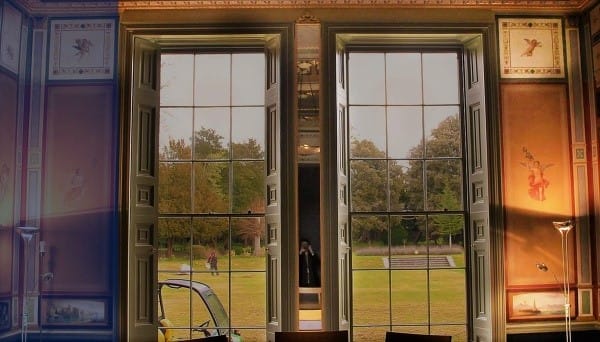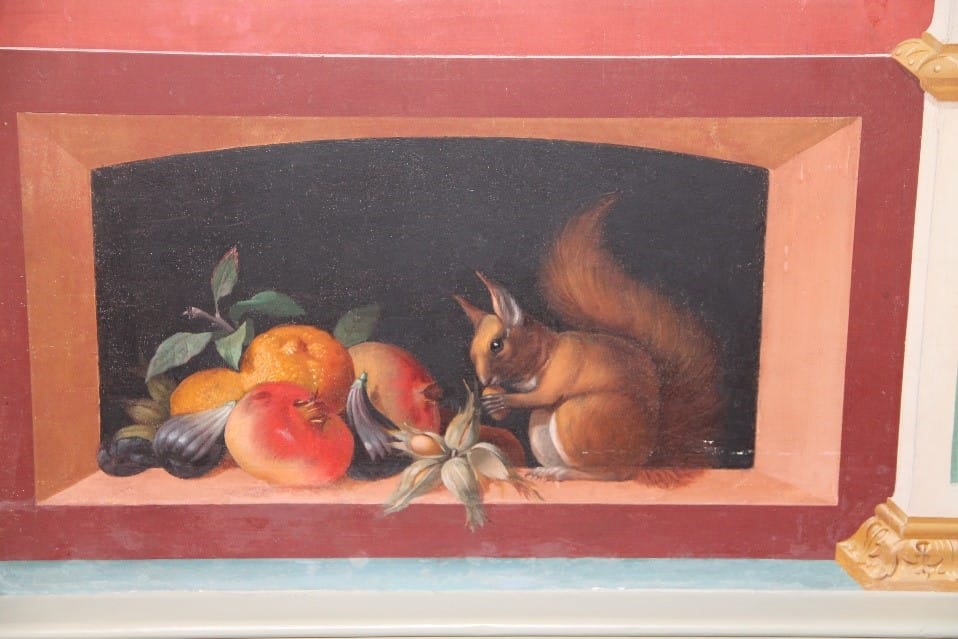Sep 24 2018
The Pompeian Room at Hinxton Hall: a corner of Pompeii that is forever England
The unique and breath-taking interior of the Pompeian Room at Hinxton Hall is what makes this modest mid-eighteenth-century country house stand out amongst many others across the country and the reason why the Hall has been awarded its Grade II* listed status. The former drawing room is covered from floor to ceiling in striking and strongly coloured nineteenth-century figurative panels inspired by wall paintings excavated from the mid-eighteenth century onwards in Pompeii and Herculaneum. It is characterised by an eclectic mix of Roman-inspired wall paintings depicting illusionistic landscapes, enthroned Roman gods, mythical creatures and delicate female figures.
Until recently, the history of the Pompeian Room at Hinxton Hall was largely unknown. The consultation of archival material relating to the Green (later de Freville) family, who lived in the Hall more or less constantly between 1799 and 1900, has allowed the history of the room to be traced back to its physical origins, revealing when, and more importantly why, the room was commissioned. Moreover, the investigation of a wide variety of eighteenth- and nineteenth-century publications documenting the findings of the Pompeian excavations, combined with a visit to the National Archaeological Museum of Naples, has permitted an in-depth analysis of the entirety of the decorative scheme adorning the walls of the room.
The history of the room
It has now been discovered that the room was completed around 1845. In a bundle of notes compiled by a certain Reverend Frederick Philip de Freville (born in 1857 and a descendant of the builder of the Pompeian Room) the following quote was uncovered:
When Edward de Freville reacquired the Hall around 1834 'he added the large drawing room and dining room and the offices and justice room. The drawing room walls were painted by Italian artists in imitation of frescoes then lately discovered at Pompeii'. Further research into his personal diaries uncovered a small but promising piece of evidence 'May 1845: Painting to begin in Hall by XXXX' (the name was illegible). It does not specify which part of the hall was painted, however taken into context with Edward's personal life and the decorative scheme of the room, it could well refer to the painting of the Pompeian Room.
The date of 1845 fits in with the date of de Freville's marriage to Julia Flower in 1846. During that period, it was rather common to have houses expanded and redecorated before one married, as a sort of gift and preparation for married life. Julia Flower was a woman of high rank with numerous influential connections, daughter of the first Lord Forrester and niece of Henry Vane, Duke of Cleveland. It is therefore likely Edward had the room commissioned in the most fashionable style of interior decoration at the time as a celebration of his marriage, and his entering into a higher sphere of polite society.
Additionally, it is possible that this celebration of their marriage is depicted on the west wall of the Pompeian Room (Figure 1). The male and female figures, together with the doves kissing on the same wall, probably represent Edward and Julia. Additionally, the mix between the military and musical items could be a representation of the couple's interests, considering Edward was major and captain in the Cambridgeshire militia. Additionally, if one looks closely, the depiction of Edward on the wall closely resembles his stone carving found on the de Freville mausoleum (Figure 1).

But marriage, fashion and entertainment might not have been the sole reasons behind the decoration of the room. It is likely that Edward de Freville also had the room decorated as a tribute to his father, Edward Green, after inheriting his Grand Tour travel diaries. Green incarnates the prototypical image of the eighteenth-century grand tourist with a tremendous passion for classical antiquity, evidenced by his meticulous travel diary and list of classical manuscripts.
The original wall paintings
Analysis of the Hinxton wall paintings has shown the degree to which these paintings were inspired by Roman originals, uncovering the extent of the re-adaptation and re-contextualisation of Pompeian ornament and figurative themes in a British nineteenth-century setting. The overall lack of narrative and intellectual content in the scenes, exemplified by the intermixing of figurative themes, serves to represent Edward de Freville's attitude towards classical antiquity.
Let's examine a few of the most relevant original depictions and their inspiration. The shaded areas in the images indicate wall paintings that had to be reconstructed.
The north wall

The north wall (Figure 2) presents two landscape panels which are mostly original. The one to the left presents hills in the background suggesting Mount Vesuvius. The silhouette of the volcano is the Pompeian motif which appears the most in nineteenth-century recreations of Pompeian interiors but ironically it is never depicted in Roman wall paintings themselves!
Even though both panels contain imaginary landscapes depicted in a nineteenth-century manner, it was extremely common to include idyllic landscapes in the wall decorations of Roman houses (Figure 3). Through these landscapes the Roman wall painters were able to break down the barriers of enclosing place, allowing the viewer to access and imagine intangible worlds.

The east wall

The depiction of the Winged Nike on the east wall is one of the most characteristic figures in Pompeian wall paintings. There are several examples of this found in Pompeii, the most similar was found in the Fourth Volume of the Antichità di Ercolano Esposte (1757)¸ the earliest published record of the Vesuvian excavations.

The south wall

The depiction of Jupiter on the south wall is strikingly similar to the one found at Pompeii in the House of the Dioscuri (Figure 7). By his side is an eagle, animal sacred to the Roman god. Classical archaeologist Sir William Gell, author of the book Pompeiana (1812), describes this fresco as having 'an air of ease, yet combined with thought and majesty'.

Below this depiction is a vignette panel showing a squirrel eating hazel nuts (Figure 8). This theme is clearly of British inspiration, the red squirrel being a native British animal, never found in Roman wall painting.

The west wall

On the west wall, above the central dark blue panel is depicted a cherub standing on a chariot drawn by ducks. The original Pompeian depiction is very similar to the Hinxton one; however, the chariot is drawn by swan rather than ducks, referring to the myth of Venus. The replacement of swans with ducks might reflect an adaptation of a Pompeian theme to a British environment, ducks being a quintessentially British animal.

If the Pompeian Room at Hinxton distinguishes itself in some manner from others of its kind, it might well be in terms of its eclecticism combined with unusual archaeological accuracy, a likely consequence of Edward de Freville's amateur but informed view of classical antiquity.
With regards to personal histories, we may be left to imagine that the unusual assiduity of the room's designers in tracing a number of Pompeian sources was the result of de Freville's belated tribute to his learned father, even if the replacement of swans with ducks, for example, might have indulged his own whimsy.
Whatever the exact biographical detail, it is surely in such details that the tension between preservation and innovation is most strikingly maintained, and which constitutes the room's charm and more importantly its significance.
Note to reader: You may have noticed that the spelling of 'Pompeian' in this article differs to our room name. The naming of the Pompeiian Room reflects an alternative spelling, which we have maintained for continuity.
The Pompeiian Room can be booked for meetings or dining. Find out more.

